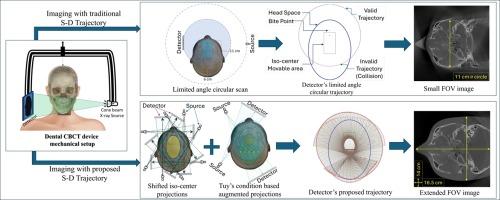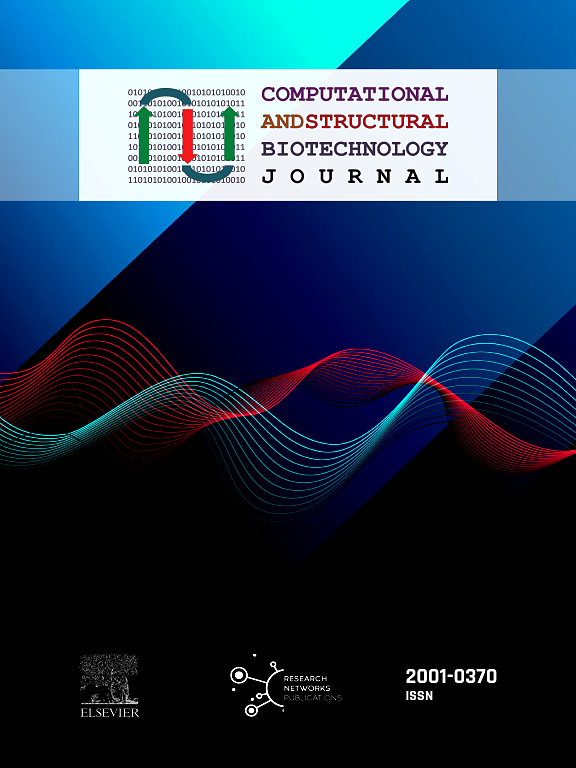Source-detector trajectory optimization for FOV extension in dental CBCT imaging
IF 4.4
2区 生物学
Q2 BIOCHEMISTRY & MOLECULAR BIOLOGY
Computational and structural biotechnology journal
Pub Date : 2024-11-08
DOI:10.1016/j.csbj.2024.11.010
引用次数: 0
Abstract
In dental imaging, Cone Beam Computed Tomography (CBCT) is a widely used imaging modality for diagnosis and treatment planning. Small dental scanning units are the most popular due to their cost-effectiveness. However, these small systems have the limitation of a small field of view (FOV) as the source and detector move at a limited angle in a circular path. This often limits the FOV size. In this study, we addressed this issue by modifying the source-detector trajectory of the small dental device. The main goal of this study was to extend the FOV algorithmically by acquiring projection data with optimal projection angulation and isocenter location rather than upgrading any physical parts of the device. A novel algorithm to implement a Volume of Interest (VOI) guided trajectory is developed in this study based on the small dental imaging device's geometry. In addition, this algorithm is fused with a previously developed off-axis scanning method which uses an elliptical trajectory, to compensate for the existing constraints and to further extend the FOV. A comparison with standard circular trajectory is performed. The FOV of such a standard trajectory is a circle of 11 cm diameter in the axial plane. The proposed novel trajectory extends the FOV significantly and a maximum FOV of 19.5 cm is achieved with the Structural Similarity Index Measure (SSIM) score ranging between (≈98-99%) in different VOIs. The study results indicate that the proposed source-detector trajectory can extend dental imaging FOV and increase imaging performance, which ultimately results in more precise diagnosis and enhanced patient outcomes.

牙科 CBCT 成像中扩展 FOV 的光源-探测器轨迹优化
在牙科成像中,锥形束计算机断层扫描(CBCT)是一种广泛用于诊断和治疗规划的成像模式。小型牙科扫描装置因其成本效益而最受欢迎。然而,这些小型系统的局限性在于视场(FOV)较小,因为光源和探测器以有限的角度在环形路径上移动。这通常会限制视场的大小。在本研究中,我们通过修改小型牙科设备的光源-探测器轨迹来解决这一问题。这项研究的主要目标是通过算法获取具有最佳投影角度和等中心位置的投影数据,而不是升级设备的任何物理部件,从而扩展 FOV。本研究根据小型牙科成像设备的几何形状,开发了一种新颖的算法来实现感兴趣体(VOI)引导轨迹。此外,该算法还与之前开发的离轴扫描方法(使用椭圆轨迹)相融合,以弥补现有的限制并进一步扩展 FOV。与标准圆形轨迹进行了比较。这种标准轨迹的视场角在轴向平面上是一个直径为 11 厘米的圆。拟议的新型轨迹大大扩展了 FOV,在不同的 VOI 中,结构相似性指数测量(SSIM)得分介于(≈98-99%)之间,最大 FOV 达到 19.5 厘米。研究结果表明,所提出的源-检测器轨迹可以扩展牙科成像 FOV 并提高成像性能,最终实现更精确的诊断并改善患者的治疗效果。
本文章由计算机程序翻译,如有差异,请以英文原文为准。
求助全文
约1分钟内获得全文
求助全文
来源期刊

Computational and structural biotechnology journal
Biochemistry, Genetics and Molecular Biology-Biophysics
CiteScore
9.30
自引率
3.30%
发文量
540
审稿时长
6 weeks
期刊介绍:
Computational and Structural Biotechnology Journal (CSBJ) is an online gold open access journal publishing research articles and reviews after full peer review. All articles are published, without barriers to access, immediately upon acceptance. The journal places a strong emphasis on functional and mechanistic understanding of how molecular components in a biological process work together through the application of computational methods. Structural data may provide such insights, but they are not a pre-requisite for publication in the journal. Specific areas of interest include, but are not limited to:
Structure and function of proteins, nucleic acids and other macromolecules
Structure and function of multi-component complexes
Protein folding, processing and degradation
Enzymology
Computational and structural studies of plant systems
Microbial Informatics
Genomics
Proteomics
Metabolomics
Algorithms and Hypothesis in Bioinformatics
Mathematical and Theoretical Biology
Computational Chemistry and Drug Discovery
Microscopy and Molecular Imaging
Nanotechnology
Systems and Synthetic Biology
 求助内容:
求助内容: 应助结果提醒方式:
应助结果提醒方式:


